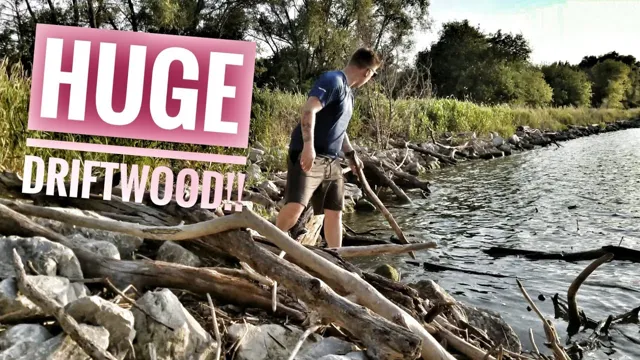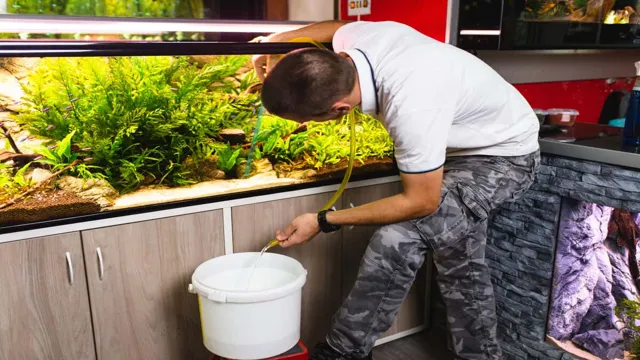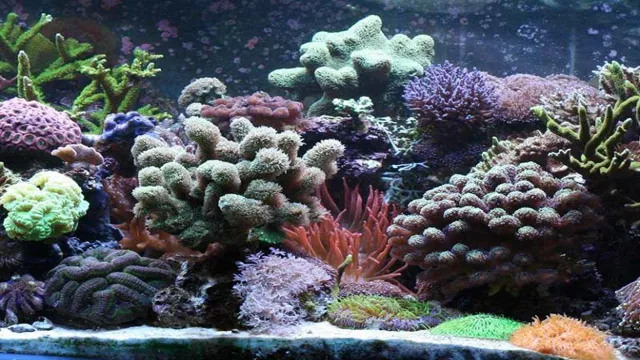How to Prepare Found Wood for Aquarium Use: A Step-by-Step Guide for Safe and Healthy Fish Habitat.

If you’re looking for an alternative way to enhance the look of your aquarium, then utilizing found wood is an excellent option. Found wood, also known as driftwood, adds a natural and rustic element to your aquarium while providing necessary hiding spots for your fish. But before you toss any old piece of wood in your aquarium, there are some critical steps you need to take to prepare the wood for use.
In this blog, we’ll go through the various methods of preparing found wood for aquarium use, including identifying safe wood types, cleaning and sanitizing, and curing the wood. Let’s dive in!
Why prepare found wood for aquarium use?
If you’re an aquarium enthusiast like me, you probably love decorating your tank with natural materials like found wood. However, before tossing that wood into your tank, it’s crucial to properly prepare it. Firstly, you want to ensure that the wood is waterlogged and won’t float to the surface and disrupt your tank’s ecosystem.
This can be achieved by soaking the wood in water for at least a week until it sinks. Next, you need to sterilize the wood to remove any harmful bacteria or parasites. Boiling the wood for at least an hour is a surefire way to achieve this.
Finally, you should sand down any rough edges or splinters to avoid injuring your aquatic pets. Overall, taking these steps to prepare found wood for aquarium use can enhance the natural aesthetics of your tank while also ensuring the safety and well-being of your aquatic friends.
Preventing Harm to Fish
If you’re an aquarium enthusiast, you must have heard about the importance of properly preparing found wood before putting it in your tank. But why is it necessary? The answer is simple: to prevent harm to your fish. Found wood, although beautiful and sometimes cheaper than store-bought driftwood, can be contaminated with harmful substances such as pesticides or diseases that could harm your fish and other aquatic life in your tank.
It’s essential to sanitize and condition the wood properly before use to ensure its safety for your aquatic pets. By boiling the found wood, you can eliminate any harmful substances or bacteria that may be present, and by soaking it for a few days, you can leach out any tannins that may discolor your water. Ensuring that the wood is safe for your fish before putting it in your aquarium is a crucial step in maintaining a healthy and thriving aquatic environment.

Preventing Algae Growth
Preparing found wood for aquarium use is essential in preventing algae growth in your tank. Algae growth can be a nuisance for aquarium owners and is caused by excess nutrients in the water. Found wood can release these nutrients into the water, encouraging algae growth.
To prevent this, it is important to properly prepare found wood before introducing it to your aquarium. This means removing any bark, sanding down rough edges, and boiling the wood to kill off any harmful bacteria or parasites. By taking these steps, you can ensure that the wood is safe for your aquatic pets and won’t contribute to excess algae growth in your tank.
Don’t skip this crucial step in aquarium setup and maintenance, and enjoy a healthy and thriving aquatic environment for your fish and plants.
Step-by-Step Process
If you’re looking to add some natural decor to your aquarium, found wood can be a great option. However, before adding it to your tank, it’s important to properly prepare it to avoid any potential harm to your aquatic pets. First, start by cleaning the wood thoroughly and scraping off any loose bark or debris.
Then, soak the wood in a container of water for several weeks, changing the water daily to remove any tannins that can discolor the water. Once the water runs clear, boil the wood for at least an hour to completely kill any bacteria or parasites. Finally, let the wood cool and dry completely before adding it to your aquarium.
It’s important to note that not all types of wood are safe for aquarium use, so be sure to do your research and avoid any potentially harmful species. With proper preparation, found wood can make a beautiful and natural addition to your underwater world.
Identifying Suitable Wood
When it comes to woodworking, choosing the right wood is essential for ensuring the quality and longevity of your project. But with so many different types of wood available, it can be overwhelming to know which one to choose. Luckily, there is a step-by-step process to follow when identifying suitable wood.
The first step is to determine the specific qualities that you need in your wood. Do you need a wood that is strong and sturdy for a piece of furniture, or do you need something more lightweight and flexible for a decorative item? Once you have identified the specific qualities, you can start researching different types of wood that meet those requirements. The next step is to consider the appearance of the wood.
Do you want a natural and rustic look, or something more polished and refined? Different woods have varying grains and finishes, so it’s important to choose one that matches your aesthetic preferences. It’s also important to consider the cost and availability of the wood. Some woods, like oak and walnut, are more expensive and harder to find, while others, like pine and cedar, are more affordable and readily available.
Finally, it’s important to take into account the environmental impact of the wood. Some types of wood, like bamboo and reclaimed wood, are more sustainable and eco-friendly than others. By following these steps and taking into account the specific needs of your project, you can confidently choose the perfect wood for your woodworking project.
So whether you’re a beginner or an experienced woodworker, take the time to carefully consider your options and select the best possible wood.
Cleaning the Wood
Cleaning wooden furniture can be a daunting task, but with a step-by-step process, it can be accomplished with ease. The first step in the cleaning process is to remove any loose dirt or debris from the furniture using a soft-bristled brush or a microfiber cloth. It is essential to avoid using harsh chemicals or abrasive materials during this process, as they can cause damage to the wood’s surface.
Once the loose dirt has been removed, the next step is to prepare a cleaning solution using warm water and a mild detergent. Dip a clean cloth in the solution and wring it out thoroughly before wiping the furniture’s surface. Be sure to work in small sections, and rinse the cloth frequently to avoid spreading dirt.
Once the entire surface has been cleaned, use a fresh microfiber cloth to dry the furniture’s surface. The final step is to apply a wood polish or wax to protect and enhance the wood’s natural shine. By following these steps, you can restore your wooden furniture’s beauty while preserving its quality.
Soaking the Wood
When it comes to preparing wood for a woodworking project, soaking the wood is a crucial step. Soaking the wood helps to make it more pliable and easier to work, especially when bending or shaping it. The process of soaking the wood is simple but requires some careful attention to detail.
First, you’ll want to choose a container that is large enough to hold the wood you want to soak. Next, you’ll need to fill the container with water and submerge the wood in the water completely. It’s important to ensure that the wood is fully submerged, so you may need to weigh it down with a heavy object.
The length of time you soak the wood will depend on the type of wood you’re using and the thickness of the piece you’re working with. Generally, you’ll want to soak the wood for several hours to overnight. Once the wood is fully soaked, remove it from the water and let it dry completely before using it in your project.
With this simple soaking process, you can make your woodworking projects much easier and more successful.
Boiling the Wood
Boiling wood is a great way to enhance its durability and improve its workability. It involves a simple process of using water to heat the wood to high temperatures, changing its structure and properties. But the question is, how do you boil wood? Well, the process is quite simple.
First, get a large pot or container that can hold the wood piece comfortably. Fill it with water and bring it to a boil. Next, carefully place the wood in the pot and let it sit for about an hour or until the wood absorbs enough water to sink entirely.
After that, continue boiling the wood for about two or three hours. Once done, let the wood cool in the water for a while before removing it. This process will make the wood moist and soft, making it easier to bend and shape while also increasing its durability and resistance to insects and rot.
Just remember, always make sure to wear protective gloves and equipment while handling the wood and the boiling water to avoid burns and injuries.
Testing the Wood
One important consideration when using wood in your aquarium is ensuring that it is safe for your aquatic inhabitants. Before adding any wood to your tank, it is essential to test it thoroughly to rule out any possible toxins or hazards. To prepare found wood for aquarium use, you should begin by cleaning it thoroughly with warm water.
You can then sterilize it by boiling it for about an hour or baking it in the oven at 250°F for around 30 minutes. Once the wood has been sterilized, it’s crucial to soak it in water for a few days, making sure the wood is fully submerged and changing the water daily. This process will help to leach out any tannins, which can discolor the water and potentially harm your aquatic life.
By testing and preparing found wood correctly, you can create a safe and natural environment for your aquatic pets to thrive in. Ultimately, with these simple steps, you can make sure that your aquarium is healthy and visually appealing while keeping the safety of your aquatic inhabitants in mind.
Assessing pH Levels
Assessing pH levels is crucial when testing the wood. pH, which stands for potential of hydrogen, indicates the acidity or alkalinity of a substance. Wood with a low pH level is acidic, while wood with a high pH level is alkaline.
Testing the pH level of wood helps to determine the possible presence of fungi, which thrive in acidic environments. Using a pH meter or litmus paper, you can accurately measure the pH level of the wood and take the necessary action to prevent any potential damage. It’s important to note that different types of wood have different pH levels, so it’s essential to research the specific wood species you are testing to get accurate results.
Remember, assessing pH levels is just one important step in testing the wood’s quality and ensuring it’s fit for its intended use.
Assessing Hardness Levels
Assessing Hardness Levels: Testing the Wood When it comes to choosing the right type of wood for your project, hardness is an important factor to consider. The hardness level of the wood you choose can affect its durability and its ability to withstand wear and tear over time. Fortunately, there are several ways to test the hardness of wood before using it for your project.
One common method is the Janka hardness test, which measures how easily the wood can be dented or scratched. This test involves pressing a small steel ball into the wood and measuring the amount of force required to do so. The higher the force required, the harder the wood.
Another method is the Brinell hardness test, which involves measuring the indentation left by a metal ball after it’s been pressed into the wood. This test can be more accurate than the Janka test and can also be used to test for changes in hardness over time due to factors such as moisture and exposure to sunlight. By testing the hardness of the wood before using it, you can ensure that your project is built to last.
Conclusion
In conclusion, preparing found wood for aquarium use is as simple as following a few easy steps. First, identify the type of wood and check for any signs of rot or decay. Then, soak the wood in water for several weeks to remove any tannins and toxins.
Finally, give it a good scrub and rinse to ensure it’s ready to be a beautiful addition to your underwater oasis. So go ahead and give your aquarium the gift of natural beauty with some carefully prepared found wood. Your fish will thank you for it, and who knows, they might even invite their wood-loving friends over for a swim!”
FAQs
Why is it important to prepare found wood for aquarium use?
Found wood may have harmful chemicals or bacteria that can affect the health of aquarium inhabitants. Preparing it properly ensures the safety of the aquarium.
What is the best way to clean found wood for aquarium use?
The best way to clean found wood is to boil it for several hours until it has soaked up enough water to sink. This helps remove any harmful substances and sterilizes the wood.
Can found wood be used immediately in an aquarium after cleaning?
No, it is important to soak the wood for several weeks before placing it in an aquarium. This prevents it from releasing tannins and harmful substances into the water.
Is it safe to use any type of found wood in an aquarium?
No, only certain types of wood are safe for aquarium use. Avoid using softwoods, those with sap, or those that have been treated with chemicals or pesticides.
How should found wood be treated before placing it in an aquarium?
Ideally, found wood should be sanded and sealed with a non-toxic sealant to prevent it from rotting or breaking down in the water.
How often should found wood be replaced in an aquarium?
It is recommended to replace found wood every few years as it may break down over time and release harmful substances into the water.
What is the best way to incorporate found wood into an aquarium design?
Found wood can be used as a centerpiece or focal point in a tank. It can also be used to create hiding places for fish or as a substrate for plants to grow on. Just be sure to choose a piece that fits appropriately in the tank and complements the overall aesthetic.






